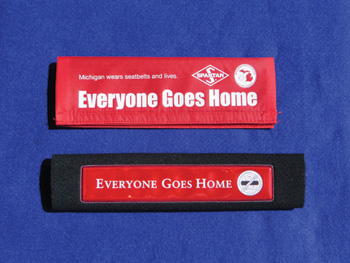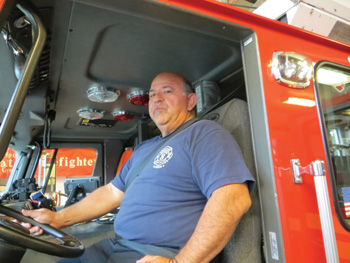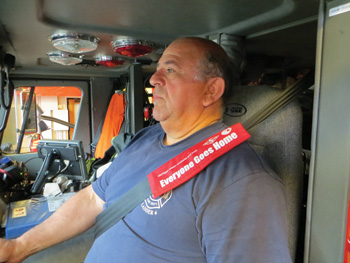By Raul A. Angulo
I used to be a lot more argumentative (opinionated) when I was younger. I’ve always enjoyed stirring up passionate debates about firefighting. The battle of wits and linguistic combat is like listening to two seasoned lawyers verbally joust in the courtroom to prove a point. But no matter how many facts and figures one has at the ready, whether your audience is a jury or firefighters (same thing), you still need to be able to articulate a position that makes sense in order to influence them and win the day. Today I usually write my positions in articles, but once in a while, when someone is discussing a subject I am passionate about, I can’t help myself and I jump into the dialog. Such was the case at the last Fire Department Instructors Conference (FDIC).
 |
| (1) The bright orange seat belt stands out behind dark contrasting backgrounds. This firefighter is seated in position four, directly behind the driver. The officer simply needs to take a quick glance. If the officer can see orange, it’s indicative that the firefighter is properly buckled in and nothing needs to be said. (Photos by author.) |
To Wear or Not to Wear Seat Belts
The discussion centered on the challenge of getting firefighters to wear their seat belts and how to enforce a seat belt policy. It would be rare to find a single fire department that doesn’t have a policy stating firefighters will wear seat belts any time the apparatus is in motion. Yet, it’s a safe bet to say there isn’t 100 percent compliance. A well-known battalion chief argued that he felt putting on seat belts slows down the response and prevents firefighters from donning their personal protective equipment (PPE) while en route, so this is a policy he does not aggressively enforce. Although he understands the policy, he feels the expectation is unrealistic and therefore not practical to enforce.
He was very articulate and persuasive about the benefit of having his firefighters ready for battle on arrival outweighing the risk of them getting into an accident. He also felt having firefighters showing up at an incident and taking the time to don all their firefighting PPE and self-contained breathing apparatus (SCBA) sends a loud negative message to the public that his crew is not prepared. He believes it would put the fire department in an inexcusable position if rescues were delayed or unsuccessful because firefighters needed to take extra time to get ready before going into action.
Envisioning a scenario with victims perishing in a fire while his firefighters are “bunking up” in front of the public is a risk he isn’t willing to take. Feeling the risk is miniscule, he would rather risk his crews getting injured or killed while responding without seat belts. This is an emotionally charged scenario, but this chief is not the only one who holds to this position. In fact, that is the number one reason firefighters don’t wear their seat belts while responding to a fire. Anything that prevents them from getting ready while en route and arriving at the scene ready for immediate action, which may save a life, is not justifiable.
 |
| (2) Seat belt sleeves are simply cosmetic covers that wrap around a black seat belt. They meet the intent of NFPA 1901 color specs, adding a bright red stripe to a black seat belt. They serve three purposes: They make the seat belt easy to identify so it isn’t confused with the black SCBA straps, they make it easy for the officer to visually check to see if crew members are buckled in, and they are visual reminders to all crew members to wear their seat belts. They are cheap and easy to make. |
Emotion vs. Reality
On the surface, this sounds like a compelling reason to ignore a seat belt policy. But this is based on emotion and not reality. So, I challenged this chief by asking a series of questions that I’m asking you now to consider.
First, 80 to 85 percent of our alarms are EMS responses. There is no urgent reason to don any equipment while en route for EMS, so it’s hard to justify not wearing seat belts for EMS alarms. Most firefighters would agree, so there’s no argument there.
Second, no matter what type of alarm we respond to, once the emergency is over and the crew is returning to quarters, there is no good reason not to wear seat belts. Most firefighters would agree, so, again, there’s no argument there.
That leaves fire responses. Although the chief’s scenario is about as ugly as it gets, I figure that 95 percent of us will go our entire career without having a fire where people are hanging out the windows and we’re not ready to go into action. Would you say that you go to one fire a year where people are hanging out the window and your crew still needs to bunk up on arrival because it was wearing seat belts? I’ve been in the fire service 35 years and that has never happened to me. The fact is, this scenario is truly a rare event and most of us will never experience it. On the other hand, do you know how many of the annual 100 (on average) line-of-duty deaths (LODDs) are directly related to a firefighter not wearing a seat belt? The answer is five.
 |
| (3) NFPA 1901 is not retroactive. Many first line apparatus still have black seatbelts. Firefighters who wear black or blue uniforms or black turnout coats may confuse the seat belt with SCBA straps. Black on black also makes it hard for the driver and officer to see if crew members are buckled in. In this photo, the driver is buckled in, but it’s hard to tell. |
No Right to Choose
Fire apparatus don’t injure or kill firefighters in new ways. Firefighters either crash, are thrown from them, or are run over by fire apparatus. All three happened at an incident on February 7, 2007, in Detroit, Michigan. While en route to a fire, the apparatus operator was involved in a crash, was thrown through the windshield of the engine, was run over by his own apparatus, and was killed. The company officer was also thrown through the windshield and critically injured. Neither firefighter wore a seat belt.
So, how do we get firefighters to wear their seat belts? It can be frustrating for well-intentioned company officers. One officer commented to me, “What am I supposed to do? Buckle them in like a child in a car seat? They have to take a certain amount of personal responsibility.”
Interestingly enough, NFPA 1901, Standard for Automotive Fire Apparatus (2009 ed.), helps firefighters and company officers out in this area. NFPA 1901 states that the fabric for all seat belts must be bright orange or red in color. For firefighters, this helps identify the seat belt strap so it isn’t confused with SCBA straps or ladder belts that may be mounted within the jump seat for quick donning. For company officers and drivers, it allows for a quick visual check to see if members are properly seat belted before the apparatus responds. If the officer sees a bright orange strap across the waist and chest of the firefighter, that firefighter is properly wearing the lap and shoulder restraints.
Unfortunately, NFPA 1901 is not retroactive. Many first-line apparatus, like my rig, still have black seat belts. Our bunker gear is also black, so you have black on black, making it difficult to see the seat belt because it blends into the color of firefighters’ coats. It also takes extra effort to see if a member is properly buckled in. But, someone came up with a clever idea.
 |
| (4) This is what the sleeve looks like when attached to a seat belt. Seat belt sleeves can be stenciled with a safety slogan or company logo. Keep it simple with a professional look. The intent is to get firefighters to wear their seat belts, not be an advertisement for the local pizza parlor. |
Seat Belt Sleeves
A few FDICs ago, Rosenbauer America came up with a brilliant marketing strategy. Instead of handing out little key chains that usually get thrown away by the end of the day or customized pens at its booth, it handed out red seat belt covers/sleeves with “Rosenbauer” stenciled on them. The material was red nylon about a foot long and was wide enough to cover a standard seat belt. You simply wrapped the sleeve around the existing seat belt and secured it with a hook and loop fastener. It’s merely a cosmetic sleeve and does not interfere with the restraint system.
But, what it does do is creatively provide for the intent of NFPA 1901 by making an existing black seat belt noticeably visible by introducing a red stripe-very clever and cheap to make. The genius of this advertising giveaway is that it made a serious attempt to address a safety issue responsible for approximately five LODDs annually. Who would think that a giveaway could have such a positive effect on reducing LODDs? These sleeves were a hot item and gone in no time.
At the following FDIC, Spartan and the Michigan Fire Chief’s Association partnered to make a new batch of red sleeves. The National Fallen Firefighters Foundation also made a fancy one using a reflective red stripe. Now you’re starting to see them everywhere. The construction of the sleeve is really irrelevant. It just needs to be red or bright orange to meet the intent of NFPA 1901, fit a standard seat belt snugly, and not interfere with the restraint system.
This is a great project for fire department support organizations like women’s auxiliaries, fire buffs, cadets, Boy Scouts and Girl Scouts, and so on. Be careful with any slogans or logos that are stenciled on the sleeve. I suggest “Everyone Goes Home,” “Seat belt secured,” or “Safety is sustainable.” Keep it simple. If a slogan is too cute or silly, firefighters won’t wear it. For logos, use the department’s insignia or stencil the name of the fire company like “Engine 8” or “Ladder 6.” Remember-the intent is to encourage firefighters to wear their seat belts, not to wear an advertisement for the local donut shop or pizza parlor. If a sponsor wants some recognition, send it an official certificate from the fire department so it can hang in its place of business. The sleeve needs to look professional. If it’s too goofy or cartoonish, it will end up in the garbage instead of on the apparatus.
For this simple tool to work, it needs to be visible. If it causes one firefighter to take notice, contemplate the message, and buckle up, it may save a life. The message isn’t printed on the sleeve; the message IS the sleeve. How many tools can take credit for that?
I used to have the same opinion as that battalion chief, thinking that buckling up interfered with my ability to don my PPE. It wasn’t until Dr. Burton Clark of the National Fire Academy challenged me to sign his national seat belt pledge that I changed my position. There was something about actually signing my name to that document that convinced me to walk the talk. I used to be about 85 percent compliant. Now I can honestly say my crew and I wear our seat belts 100 percent of the time. After our conversation, the battalion chief changed his mind, too.
No matter what reasoning or scenario you have planted in your head that excuses you from wearing your seat belt, ask yourself which of the chief’s scenarios is most likely to happen by the end of the year.
RAUL A. ANGULO, a veteran of the Seattle (WA) Fire Department and captain of Ladder Company 6, has more than 30 years in the fire service. He is a member of the Fire Apparatus & Emergency Equipment editorial advisory board. He lectures on fire service leadership, company officer development, and fireground strategy and accountability throughout the United States, Canada, and Mexico.

